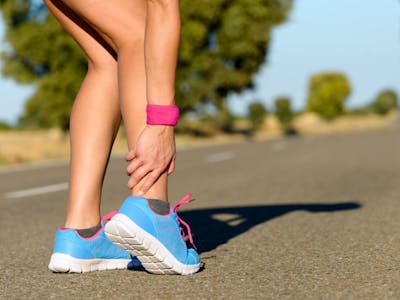
Sprains and strains are common injuries that we sustain with daily activities, recreation, and competitive sports. But what is a sprain and what is a strain?
Sprains and strains are common musculoskeletal injuries that occur around the joints as a result of daily activities, recreation, and competitive sports. Common causes include improper lifting techniques, repetitive movements at work, home, or school, and traumatic injuries (e.g., abrupt falls with twisting or pivoting movements, etc.).
The symptoms of sprains and strains are similar, which is why they are so easily confused.
-
Sprain
- Bruising
- Pain around the injured joint
- Edema (swelling)
- Limited flexibility and range of motion due to pain
Strain
- Muscle spasms
- Pain around the injured joint
- Edema (swelling)
- Limited flexibility and range of motion due to pain
The major difference with the symptoms is that there is bruising around the injured joint on a sprain, and with a strain, muscle spasms occur.
What is a strain?
A strain is the tearing of muscle fibers. Muscle fibers are the individual units that make up your muscles. When you call upon the muscle to perform strong or repeated contractions, you may suffer a strain. Strains are classified into grades I, II, and III; grade I is mild, grade II is moderate, and grade III is severe.
- A grade I strain is a mild disruption of the muscle fibers. There may be mild swelling, mild tenderness, and it may be painful to stretch and use the injured muscle.
- A grade II muscle strain indicates moderate muscle fiber damage. The pain is moderate to severe, it definitely hurts to use and stretch the injured muscle, and ecchymosis may be present. Ecchymosis (commonly called bruising) indicates that there was internal damage to blood vessels that resulted in bleeding within and around the muscle. This bleeding is often visible under the skin as a purple, blue, red, yellow, and even green in color.
- A grade III strain is the most severe. It is the complete tearing of a muscle into two pieces, or separation of the muscle from its associated tendon. There is severe pain, complete loss of muscle strength, swelling is normally present with ecchymosis, and there may be a palpable "indentation" where the muscle is torn. Medical intervention is usually necessary. Typically, an orthopaedist (musculoskeletal specialist) will evaluate your condition and surgical repair may be necessary.
What is a sprain?
Sprains are tears of the ligaments and capsules (tissues around joints). Ligaments are made up of bundles of somewhat elastic, collagen tissue and attach one bone to another. Capsules typically partially or completely surround a joint. In a synovial joint, there is lubricating and nourishing fluid within the capsule called synovial fluid.
Like strains, sprains are classified as grade I, II, or III in their severity.
- A grade I sprain involves a minimal number of ligament fibers. There may be pain, swelling, and only mild loss of function.
- A grade II sprain is a moderate or partial ligament tear. There is usually moderate to severe pain, swelling and bruising are typically present, and there is a loss of joint function (e.g., it is extremely difficult or you are unable to walk on a grade II ligament sprain of the ankle).
- A grade III sprain is a complete tearing of the ligament or joint capsule into two pieces. Severe pain, swelling, bruising, and loss of function are associated with a grade III sprain. As with grade III strains, orthopaedic intervention/surgical repair may be necessary.
Treatment for Sprains and Strains
Directly after a sprain or strain, control the swelling with RICE for 24 to 48 hours:
- Rest the injured joint/extremity and use a sling for an arm or shoulder injury or crutches for a leg or foot injury.
- Ice for 20 minutes every hour.
- Compress with an elastic Ace bandage or brace for an ankle or knee, a splint for an injured finger or buddy-taping for an injured toe.
- Elevate above the heart, if possible.
An over-the-counter acetaminophen, such as Tylenol® or non-steroidal anti-inflammatory drug (NSAID), such as Advil® may help with reducing the swelling and pain/ pressure relief. After this home treatment, be sure to have the injury evaluated by your doctor to rule out a fracture or a severe sprain or strain.
Most mild sprains and strains heal with a few days to a week. Seeing a physical therapist can also help you regain range of motion. Your physical therapist can also show you injury prevention techniques to help prevent future sprains and strains.
If your symptoms don't improve within a couple of days, or you experience any of the following, see your doctor to have it immediately evaluated:
- An audible "popping" sound with the injury
- Pain and swelling that gets worse over time
- Fever or chills
- Difficulty standing or walking without pain
- Limited flexibility and range of movement around the injured joint
- Numbness or tingling
- Joint/extremity deformity or signs of instability
Moderate sprains and strains may require bracing for a period of time, followed by physical therapy to help regain normal function and range of motion. Severe sprains and strains may require surgery to repair the tear, followed by physical therapy to rehabilitate the injury.
Resource:
- Ralphs JR, Benjamin M. The joint capsule: structure, composition, ageing and disease. J Anat. 1994;184 ( Pt 3)(Pt 3):503-509.

